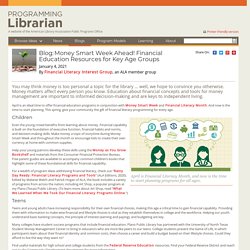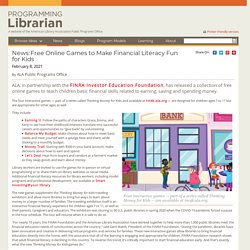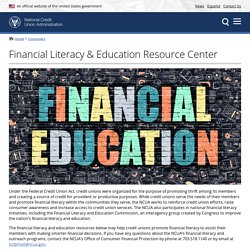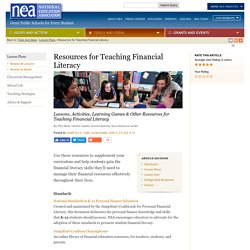Zoom
Trash

Money Smart Week Ahead! Financial Education Resources for Key Age Groups. You may think money is too personal a topic for the library … well, we hope to convince you otherwise.

Money matters affect every person you know. Education about financial concepts and tools for money management are important to informed decision-making and are keys to independent living. April is an ideal time to offer financial education programs in conjunction with Money Smart Week and Financial Literacy Month. And now is the time to start planning. This spring, give your community the gift of financial literacy programming for every age. April is Financial Literacy Month, and now is the time to start planning programs for all ages. Children Even the young crowd benefits from learning about money. Help your young patrons develop these skills using the Money as You Grow Bookshelf and materials from the Consumer Financial Protection Bureau. Teens Many colleges have student success programs that include financial education. Adults Older adults Don’t forget your seniors! Young Adults and Investing.
Personal Finance. It's important to know what you want to accomplish with your investments before you actually invest.

Learn how to set your financial goals, get a handle on your cash flow, control spending, manage debt, and get on the path to saving and investing. Set Your Financial Goals Just as in other aspects of your life, setting financial goals is a tried-and-true way to reach those goals. Federal Reserve Education. Money Smart Week Ahead! Financial Education Resources for Key Age Groups. Building a Financially Capable America Through Education and Research. Free Online Games to Make Financial Literacy Fun for Kids. ALA, in partnership with the FINRA Investor Education Foundation, has released a collection of free online games to teach children basic financial skills related to earning, saving and spending money.

The four interactive games — part of a series called Thinking Money for Kids and available at tm4k.ala.org — are designed for children ages 7 to 11 but are appropriate for other ages as well. Four interactive games — part of a series called Thinking Money for Kids -- are available at tm4k.ala.org. They include: Library workers are invited to use the games for in-person or virtual programming or to share them on library websites or social media.
Additional financial literacy resources for library workers, including model programs and professional development, are available at Smart investing@your library. The new games supplement the Thinking Money for Kids traveling exhibition and allow more libraries to bring fun ways to learn about money to a larger number of families. Moneytopia. Understanding Taxes - Simulations. SPENT. Grades K-12 Financial Literacy Resources - Financial Literacy. Ww2.kqed. Fostering Financial Literacy in ESL Classrooms Using New Media Tools In these lessons students learn about managing money, banking, credit, debt, home financing and loans while practicing listening, reading, speaking and writing skills.
By integrating new media tools into the curriculum we hope educators will be able to engage ESL learners by making unfamiliar financial concepts as concrete as possible. Educators – How to Use This Site Target group – from high beginning to low intermediate adult English language learners, in particular low-income, recent-arrival immigrants and refugees, to high-intermediate and advanced ESL students in academic-credit classes – these lessons could be adapted for noncredit and lower-level students. Four steps Students Tell us what you think — fill out our surveys at the end of the lessons or activities. Six Lesson Plans 1. Lesson PlanFinancial Literacy Unit (PDF) New Media Tool to use in the lessonBudget Builder Calculator Take the Teacher Survey 2. 3. 4. OCC: Financial Literacy Resource Directory. Financial Literacy & Education Resource Center. Under the Federal Credit Union Act, credit unions were organized for the purpose of promoting thrift among its members and creating a source of credit for provident or productive purposes.

While credit unions serve the needs of their members and promote financial literacy within the communities they serve, the NCUA works to reinforce credit union efforts, raise consumer awareness and increase access to credit union services. Ofe cfap resources. Resources for Teaching Financial Literacy. By Phil Nast, retired middle school teacher and freelance writer Found In: health & p.e., math, social studies, preK-2, 3-5, 6-8, 9-12 Use these resources to supplement your curriculum and help students gain the financial literacy skills they’ll need to manage their financial resources effectively throughout their lives.

Standards National Standards in K-12 Personal Finance Education Created and maintained by the Jump$tart Coalition® for Personal Financial Literacy, this document delineates the personal finance knowledge and skills that K-12 students should possess. NEA encourages educators to advocate for the adoption of these standards to promote student financial literacy. Jump$tart Coalition Clearinghouse An online library of financial education resources, for teachers, students, and parents. Lesson Plans. Interactive Library.